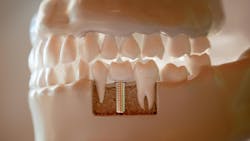Beyond maintenance: Expanding the vocabulary of implant dentistry
In many ways dental implants have evolved since the days of the early Mayans in 600 AD where shells were used to replace teeth, yet in many other ways we are still in the infancy stage of implants. Well, maybe not infancy but at least adolescence! There is much information currently available about implants but a lot is still not understood.
As hygienists, it is our responsibility to care for dental implants both from the professional and patient standpoints, thereby causing no harm. Numerous articles have been written about the pros and cons of implant maintenance, but do you understand what you are maintaining? This article will review some of the basics of implant parts and pieces to allow you to make better, more informed decisions regarding implant maintenance.
There are many implant manufacturers in the dental marketplace today. Many remain independent, while others are being merged with previous competitors. The landscape of dental implant products and companies is constantly changing. No one article can attempt to discuss all of the various aspects of implant components, since every company has a variety of mechanisms involved in the implant process. As a result, this article will only discuss some of the basics inherent to dental implants.
The history of implants
From the early Mayans to the Egyptians and even to George Washington (whose teeth were made of ivory, gold, and extracted human and animal teeth, not wood) humans have been trying various implements to replace teeth ravaged by oral disease. In the late 1800s and early 1900s, physicians were experimenting with teeth replacements using metals and drills the principles of which are the foundations of procedures and products used today.
In the 1950s, Dr. Per-Ingvar Brånemark, a Swedish orthopedic surgeon, discovered that titanium bonded with bone in rabbits. He coined the phrase "osseointegration" as the direct biological attachment of metal titanium to living bone. Since pure titanium had been used for years in medicine, initially dental implants were constructed of this medical grade material, but durability and longevity testing proved that titanium alloys are better choices for dental implants.
During the 1960s and 1970s, subperiosteal, transosteal, and blade implants were commonly used. In 1981 Dr. Brånemark published his research findings from animal and human studies regarding the success rate and design of the currently used endosteal root-form implants. During the Toronto Implant Conference of 1982, osseointegration and its effects on edentulism were introduced to North America with guidelines as to the standardization of implant success criteria. This conference was groundbreaking and led to the establishment of implant organizations, publications, and companies. It's hard to believe this was only 30-plus years ago!
In 1986 dental implants became an officially recognized treatment by the American Dental Association. During the years of 1988-1992, an explosion in the number of implants placed occurred. Today implants are considered the standard of care for edentulous areas and are regulated by the FDA (Food and Drug Administration).
As hygienists, we see patients who have implants placed and restored, as well as other patients who could benefit from having implants if they are viable candidates. With all of this history, what are hygienists actually dealing with?
Understanding the parts
Dr. Brånemark and fellow researchers found that titanium alloys were the best for dental implants. Why titanium? It is bone loving (osseophilic), strong as steel but much lighter, biocompatible, noncorroding, and a poor electrical and heat conductor, but it does scratch easily. Dental implants are coated to increase the implant's surface area for better osseointegration. Depending on the manufacturer, coatings can be made of a variety of materials and coating techniques.
Implants today
The most commonly placed implant today is the root-form implant, although subperiosteals can also be placed (subperiosteals don't need osseointegration to function while root-form implants do). Root-form implants can either be press-fit cylindrical or screw-type threaded implants. Each has definite indications and uses. The average width of an implant is approximately 3.75 mm but can be also mini-, narrow-, or wide-body implant widths, depending on use. Lengths of implants vary among manufacturers anywhere from 7 mm to 15 mm.
The three main components of dental implants are the implant body, the abutment, and the prosthesis. Each implant manufacturer develops a variety of implant bodies with varying lengths, widths, surface textures, and designs.
The implant body is the component that sits in the bone and must osseointegrate for success. One-piece implants have the implant body and the abutment together in one piece. Two-piece implants have the implant body with a neck, collar, and platform that contains either an internal or external connection for the abutment.
The abutment connects the implant body to the prosthesis and can be fabricated in a number of materials including titanium, gold, zirconium, porcelain, or ceramic. Abutments are screwed into the two-piece implant body and are either cemented or screwed onto the prosthesis. Abutments can also be premade or custom-made depending on the needs of the patient and clinician. Implant placement and prosthetic design, along with clinician preferences, dictate what type of abutment is used. Abutments are smooth in contrast to implant bodies, which are roughened. Bone attaches best to a roughened surface, while soft tissue attaches best to a smoother surface. On top of the abutment sits the prosthetic restoration. The restoration can be a removable denture, fixed denture, cemented crown or bridge, or screw-retained crown or bridge.
What you should know
Implant dentistry is designed with the end in mind (i.e., what is the final prosthetic result desired?). Questions that the clinician must ask include:
✓ What is the final result the patient desires?
✓ How many implants are needed to support the result?
✓ Where are the implants going to be placed to achieve proper support, esthetics, phonetics, and function of the prosthesis?
During the surgical phase of implant dentistry, the placing dentist has several options: a single one-stage surgery, a two-stage surgical procedure, or an immediate-load procedure. A number of factors including type and amount of bone, location, and other considerations will determine whether a one- or two-stage procedure is performed. An immediate-loaded restoration allows for the placement of the implant body, abutment, and restoration out of occlusion at the time of surgery and is determined by a variety of factors.
Depending on the situation, a cover screw or healing abutment can be placed at the time of surgery into the implant body to allow for healing. Cover screws are placed into the implant body to prevent bone or soft tissue from entering the internal component of the implant and can be sealed over in two-stage surgical procedures or seen intraorally in single-stage surgery. Healing abutments are also screwed into the implant body but extend into the gingival tissue to begin the formation of tissue contours and the emergence profile and can be used in the single-stage procedure or following implant exposure in the two-stage process.
The surgical process itself consists of a number of parts, pieces, and instruments. In addition to the traditional surgical instruments, these can include but are not limited to:
- Handpieces, drilling instruments, and adaptors
- Irrigating solutions
- Bone grafting materials
- Distance and alignment indicators
- Pins and positioners
- Reference spheres and depth gauges
- Surgical cassettes and screw containers
- Ratchets, wrenches, screwdrivers, and torque drivers
- Depth stops
- Osteotomes and mallets
- Cover screws and healing abutments
- Brushes and handles
During the restorative phase of treatment, impressions are needed to create the restoration as in traditional dentistry. Whether traditional impressions or digital impression systems are used, the implant placement must be re-created in the model for prosthetic design. Each situation will determine what type of impression coping, body, or post is used in the impression process. Digital scan guides can also be fabricated for surgical placement when using digital impression systems. Parts, pieces, and instruments involved in the prosthetic component include but are not limited to:
- Prefabricated abutments (angled and straight) and cassette holders
- Transfer aids/abutment jigs and stabilization pins
- Guide pins, screw, and abutment drivers
- Impression and model copings and analog bodies
- Drill keys, scan posts, and scan bodies
- Screws, clips, and caps
- Retraction aids if using digital impression systems
- Implant stability monitor
In the case of a full-denture prosthesis, whether fixed or removable, additional parts are also required. In the case of a fixed removable screw-retained prosthesis, abutment screws directly attach the restoration to the implant and must be removed by a dental professional. In the removable tissue-supported or implant/bar-supported prosthesis, the prosthesis will contain a female component that is attached to the male component of the implant. These components are either clips, Locators, O-rings, or ball attachments as determined by the prosthesis design. Since the patient removes the prosthesis, the components may wear over time and need to be replaced. This replacement can occur during the implant maintenance appointment or sooner as necessary.
The first reference in the implant research literature of hygiene maintenance did not occur until 1994, 12 years after the Toronto Implant Conference. In 2011 the European Federation of Periodontology coined the terms peri-mucositis and peri-implantitis. Today these terms are part of our dental vocabulary.
As implant knowledge expands, the terms, parts, and pieces will continue to grow. Manufacturers will continue to evolve, adding more types of implant bodies, abutments, and attachments. Achieving shorter osseointegration times will result in improved materials. As digital dentistry becomes more mainstream with CAD/CAM and 3D imaging, the types of abutments and restorations will continue to develop. Using digital imaging and the website whatimplantisthat.com, dental teams can determine the specific implant that is placed, and from there, determine the parts and pieces associated with that particular implant. Understanding the parts and pieces used in implantology gives the hygienist a good foundation to build an effective implant maintenance protocol.
Editor's note: This article was originally published in 2016 and has been updated as of November 2025.
References
- Misch CE. Contemporary Implant Dentistry. 3rd ed. St. Louis, MO: Mosby, Inc.; 2008.
- Wingrove SS. Peri-Implant Therapy for the Dental Hygienist. Ames, IA: John Wiley & Sons, Inc.; 2013.
- Schetritt A. Join the ADIA. Association of Dental Implant Auxiliaries. Dental Hygiene Implant Certification Program. International Congress of Oral Implantologists website. https://www.icoi.org/adia-association-of-dental-implant-auxiliaries/ Published March 22, 2016. Accessed July 22, 2016.
- Straumann Implants. Straumann USA website. http://www.straumann.us/en/professionals.html. Accessed July 22, 2016.
- Dentsply Implants. Dentsply International website. https://www.dentsply.com/en-us/implants.html. Accessed July 22, 2016.
- Farley N, Howell K. What implant is that? Whatimplantisthat.com website. http://whatimplantisthat.com. Published February 2010. Accessed July 22, 2016.
- Norkin FJ. An era of evidence-based implant dentistry: 30 years since Toronto. Compend Contin Educ Dent. 2012;33(8 ):618-619. http://www.dentalaegis.com/cced/2012/09. Accessed July 22, 2016.
About the Author

Ann-Marie DePalma, MEd, RDH, CDA, FAADH, FADIA
Ann-Marie is a graduate of Forsyth School for Dental Hygienists, Northeastern University, and University of Massachusetts Boston. Her passion, dedication, and expertise inspire dental professionals through her CE programs and publications. She has experience as a clinical hygienist, a faculty member, consultant, and software trainer, and is a fellow in several dental hygiene organizations. Ann-Marie is an Esther Wilkins Distinguished Alumni of Forsyth Award recipient. Beyond dentistry, Ann-Marie volunteers in several local community organizations.
